Architectural Glazed Tiles Used in Ancient Chinese Screen Walls (15th–18th Century AD): Ceramic Technology, Decay Process and Conservation
Abstract
:1. Introduction
1.1. Chinese Glazed Tiles
1.2. The Glazed Tiles on the Screen Walls of the Hancheng Confucian Temple and Town God’s Temple Building Complexes
2. Materials and Methods
2.1. Sample Information
2.2. Analytical Methods
2.2.1. Scanning Electron Microscopy (SEM) with Energy Dispersive Spectroscopy (EDS)
2.2.2. X-ray Diffraction (XRD)
2.2.3. Analytical Methods for Degradation Process
3. Results and Discussion
3.1. Manufacturing Techniques Reflected by Composition and Textural Morphology
3.1.1. Body
3.1.2. Glaze
Green, Yellow and Brown Glazes
Turquoise Glaze
3.2. Degradation Process
3.2.1. Glaze Cracking and Shedding
3.2.2. Body Salt Efflorescence
3.3. Conservation Suggestions
3.3.1. Water Proofing
3.3.2. Desalination
3.3.3. Reproduction
4. Conclusions
Author Contributions
Funding
Acknowledgments
Conflicts of Interest
References
- Pang, T. Some Chinese glazed tiles of the 6th Century. Orient. Art 1999, 44, 61–68. (In Chinese) [Google Scholar]
- Duan, H.Y.; Kang, B.Q.; Ding, Y.Z.; Dou, Y.C.; Miao, J.M. Research of technology of Qing dynasty official Glazed tile bodies in Beijing. J. Build. Mater. 2012, 15, 430–434. (In Chinese) [Google Scholar]
- Ding, Y.Z.; Li, H.; Kang, B.Q.; Chen, T.M.; Miao, J.M. A Preliminary study on the technological process of the architectural glazed tiles during the Ming and Qing dynasties in Beijing Area. J. Gugong Stud. 2015, 1, 159–169. (In Chinese) [Google Scholar]
- Kang, B.; Groom, S.; Duan, H.; Ding, Y.; Li, H.; Miao, J.; Lu, G. The ceramic technology of the architectural glazed tiles of Huangwa Kiln, Liaoning Province, China. In Craft and Science: International Perspectives on Archaeological Ceramics; Martinón-Torres, M., Ed.; Bloomsbury Qatar Foundation, Hamad bin Khalifa University Press: Doha, Qatar, 2014; pp. 213–224. [Google Scholar]
- Kang, B.Q.; Li, H.; Miao, J.M. Research on the Qing dynasty glazed tiles with date inscriptions of the Forbidden City. Cult. Relics South. China 2013, 2, 67–71. (In Chinese) [Google Scholar]
- Cheng, L.; Feng, S.; Li, R.; Lu, Z.; Li, G. The provenance study of Chinese ancient architectonical colored glaze by INAA. Appl. Radiat. Isot. 2008, 66, 1873–1875. [Google Scholar] [CrossRef] [PubMed]
- Adili, D.; Zhao, J.; Yang, L.; Zhao, P.; Luo, H. Protection of glazed tiles in ancient buildings of China. Herit. Sci. 2020, 8, 37–48. [Google Scholar] [CrossRef]
- Zhao, J.; Li, W.D.; Luo, H.J.; Miao, J.M. Research on protection of the architectural glazed ceramics in the palace museum, Beijing. J. Cult. Herit. 2010, 11, 279–287. [Google Scholar] [CrossRef]
- Duan, H.Y.; Miao, J.M.; Li, Y.; Kang, B.Q.; Li, H. Research on diseases and damages to green-glazed tiles on Chinese traditional architecture. J. Palace Mus. 2013, 166, 114–124. (In Chinese) [Google Scholar]
- Ding, Y.Z.; Duan, H.Y.; Kang, B.Q.; Wu, J.M.; Miao, J.M. Study on the provenance of raw materials of the body of the architectural glazed tiles from Nanjing Baoensi Pagoda. China. Ceram. 2011, 47, 70–75. (In Chinese) [Google Scholar]
- Wu, M.Q.; Wen, Q.Z.; Pan, J.Y.; Diao, G.Y. Mass-weighted average of major chemical compositions of the Malan Loess in China. Prog. Nat. Sci. 1996, 5, 92–100. (In Chinese) [Google Scholar]
- Wood, N. Chinese Glazes: The Origins, Chemistry, and Recreation, 2nd ed.; University of Pennsylvania Press: Philadelphia, PA, USA, 2011; pp. 12, 197. [Google Scholar]
- Kang, B.Q.; Li, H.; Duan, Y.H.; Ding, Y.Z.; Zhao, L.; Lei, Y. Research on the Yuan dynasty raw materials and firing technique of turquoise-glazed tiles excavated from the Palace Museum. J. Palace Mus. 2018, 1, 191–199. (In Chinese) [Google Scholar]
- Tian, S.; Li, Z.; Wang, Z.; Jiang, E.; Wang, W.; Sun, M. Mineral composition and particle size distribution of river sediment and loess in the middle and lower Yellow River. Int. J. Sediment Res. 2021, 36, 392–400. [Google Scholar] [CrossRef]
- Maggetti, M. Phase analysis and its significance for technology and origin. In Archaeological Ceramics; Olin, J.S., Franklin, A.D., Eds.; Smithsonian Institution: Washington, DC, USA, 1982; pp. 121–133. [Google Scholar]
- Ventolà, L.; Cordoba, A.; Vendrell-Saz, M.; Giraldez, P.; Vilardell, R.; Saline, M. Decorated ceramic tiles used in Catalan Modernist Architecture (c.1870 to c.1925): Composition, decay and conservation. Constr. Build. Mater. 2014, 51, 249–257. [Google Scholar] [CrossRef]
- Gliozzo, E. Ceramic technology. How to reconstruct the firing process. Archaeol. Anthropol. Sci. 2020, 12, 1–35. [Google Scholar] [CrossRef]
- Duan, H.Y.; Ding, Y.Z.; Liang, G.L.; Dou, Y.C.; Miao, J.M. The chemical composition characteristic and firing technology research on ancient building glazed tile bodies in China. China Ceram. 2011, 47, 69–72. (In Chinese) [Google Scholar]
- Tite, T.S.; Freestone, I.; Mason, R.; Molera, J.; Vendrell-Saz, M.; Wood, N. Lead glazes in antiquity—methods of production and reasons for use. Archaeometry 1998, 40, 241–260. [Google Scholar] [CrossRef]
- Miao, J.M.; Wang, S.W. Research on the architecture glazed tiles of Yuan, Ming and Qing dynasties. In Proceedings of the 05 International Symposium on Ancient Ceramics, Shanghai, China, 1–5 November 2005; pp. 108–115. (In Chinese). [Google Scholar]
- Feng, M. Research on the origin of turquoise glaze technology. Cult. Relics Cent. China 2020, 211, 126–132. (In Chinese) [Google Scholar]
- Li, J.Z. A History of Science of Technology in China-Volume of Ceramic; Science Press: Beijing, China, 1998; p. 474. (In Chinese) [Google Scholar]
- Lawrence, W.G.; West, R.R. Ceramic Science for the Potter; Chilton Book Co.: Radnor, PA, USA, 1982; p. 182. [Google Scholar]
- Miao, J.M.; Wang, S.W.; Duan, H.Y.; Kou, Y.C.; Ding, Y.Z.; Li, Y.; Li, H.; Kang, B.Q.; Zhao, L. Research on the elements in the vitreous glazed components used in ancient Chinese Buildings. J. Palace Mus. 2008, 5, 115–129. (In Chinese) [Google Scholar]
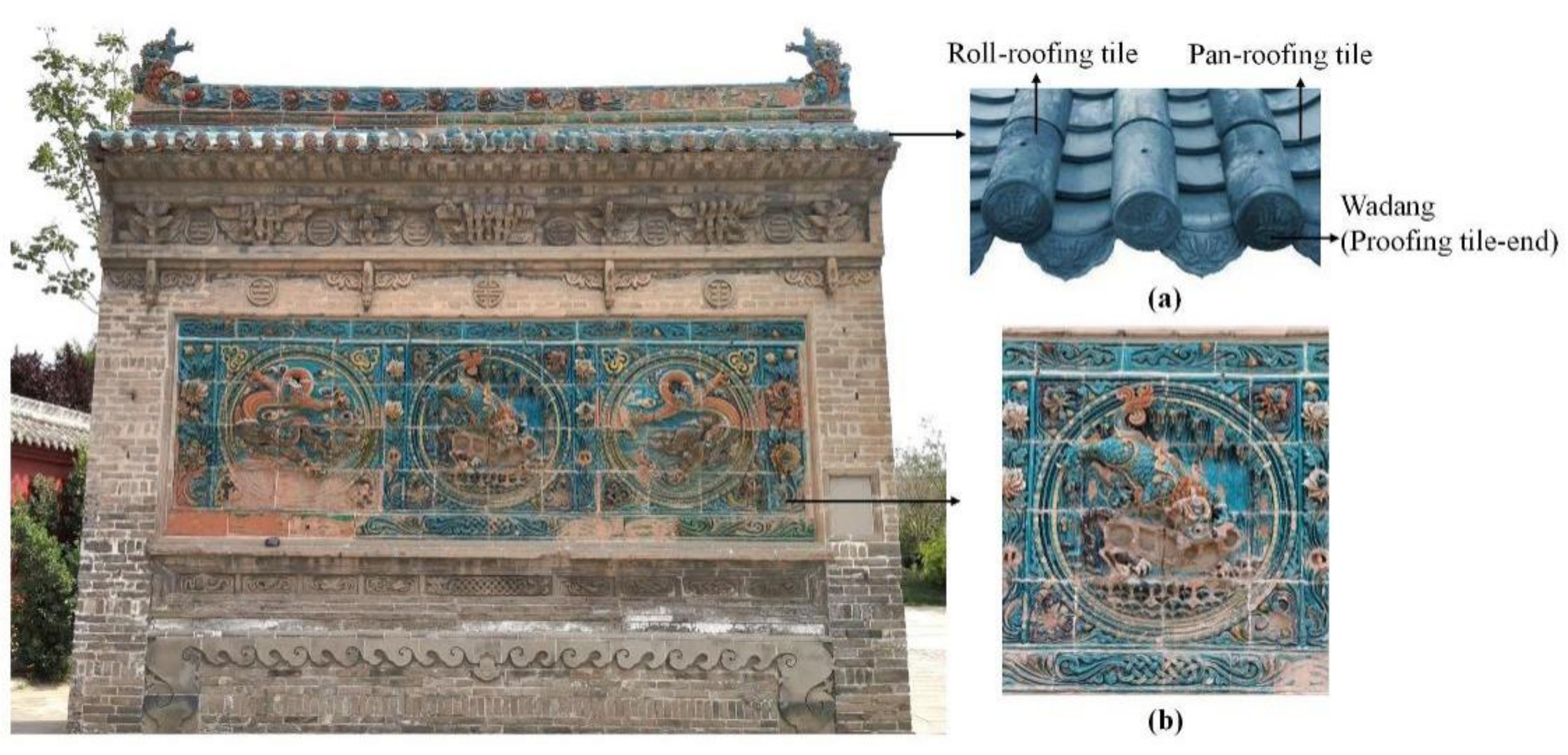
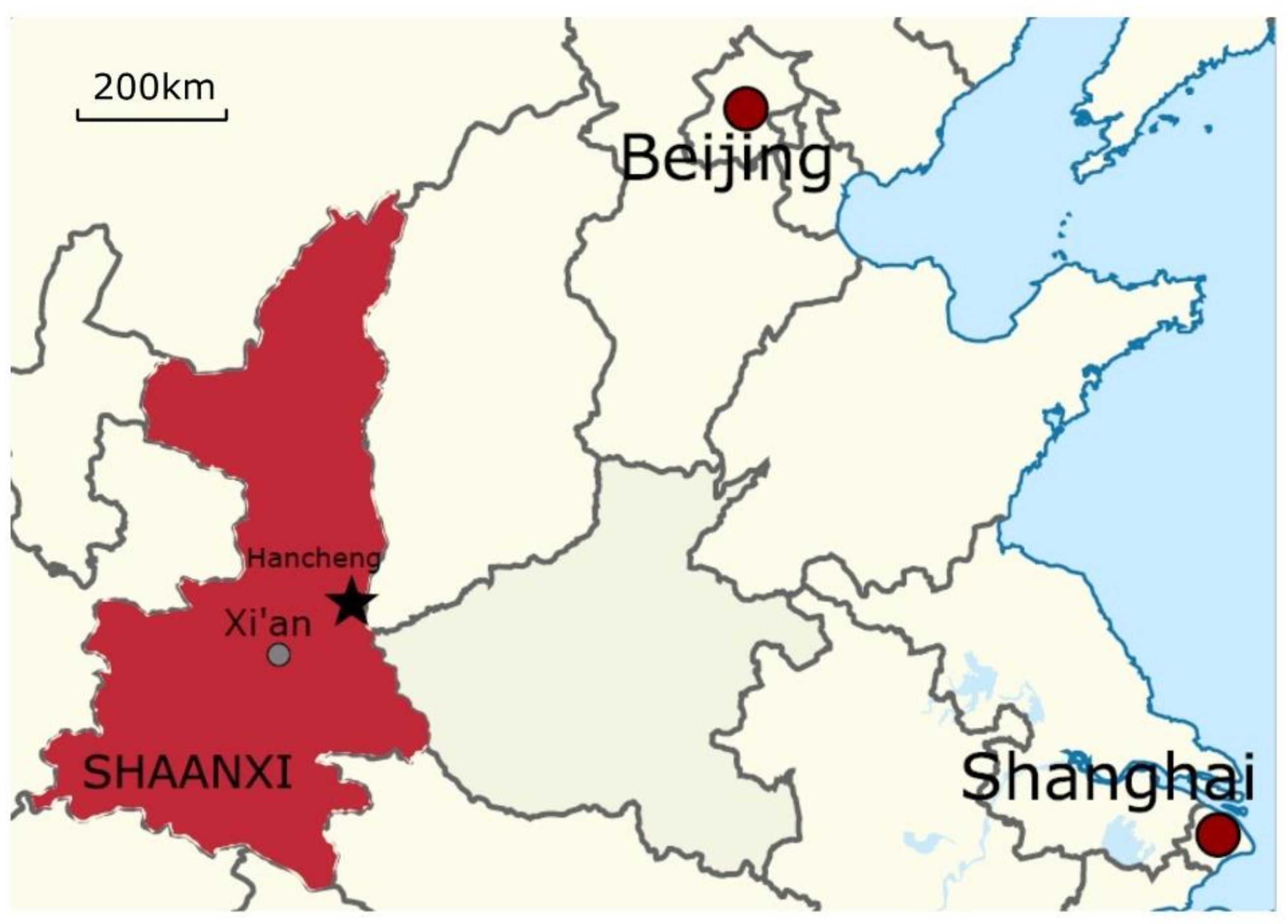
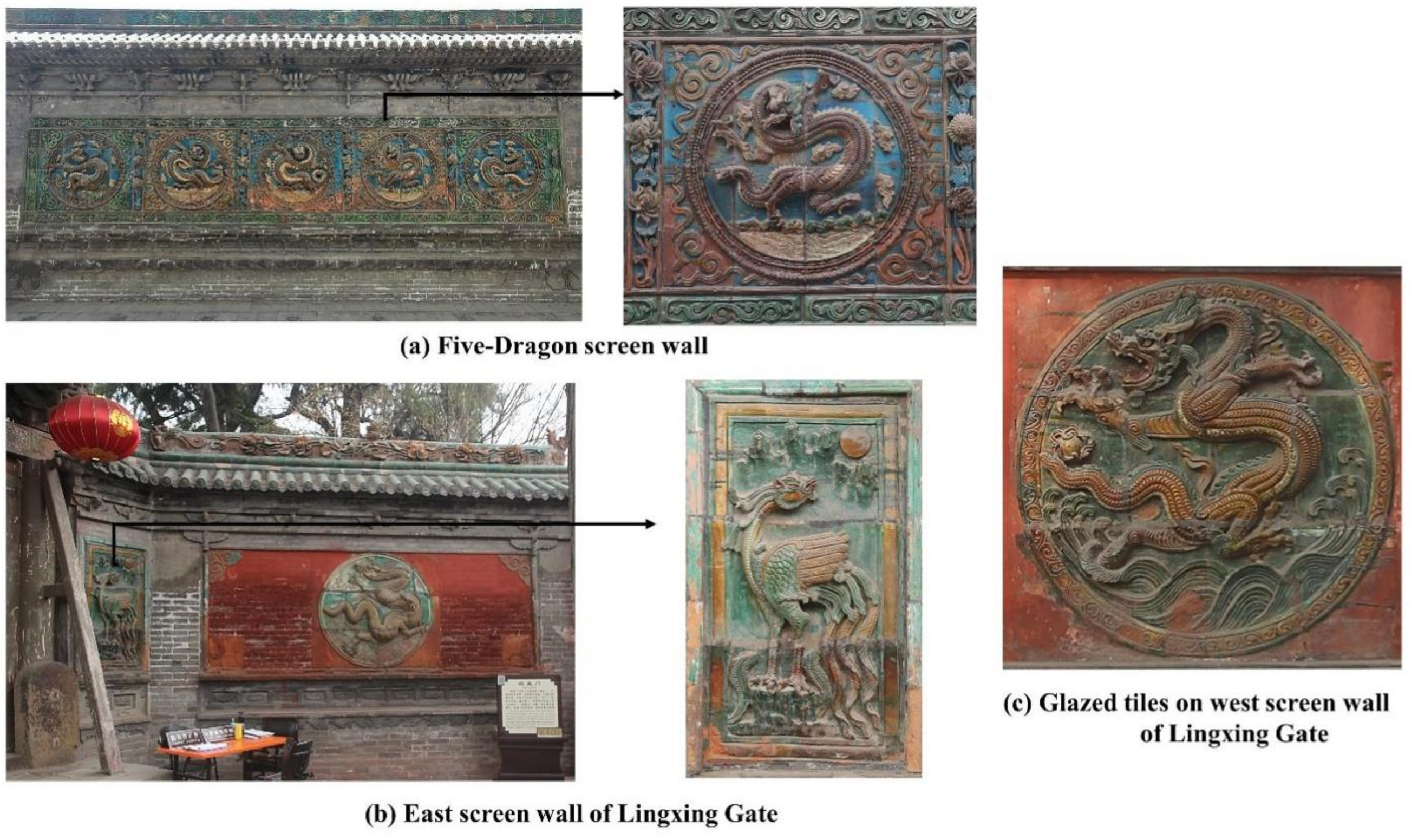
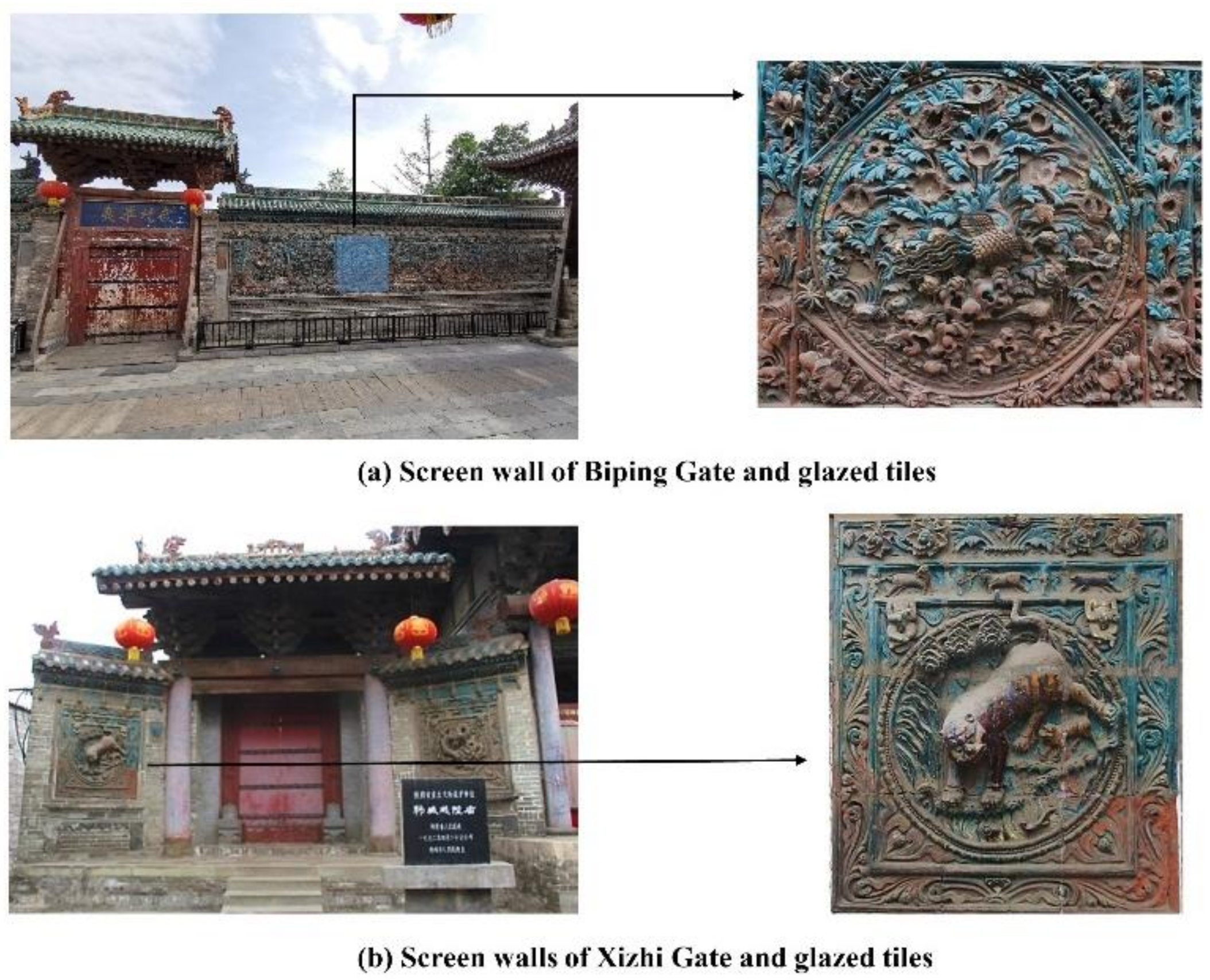
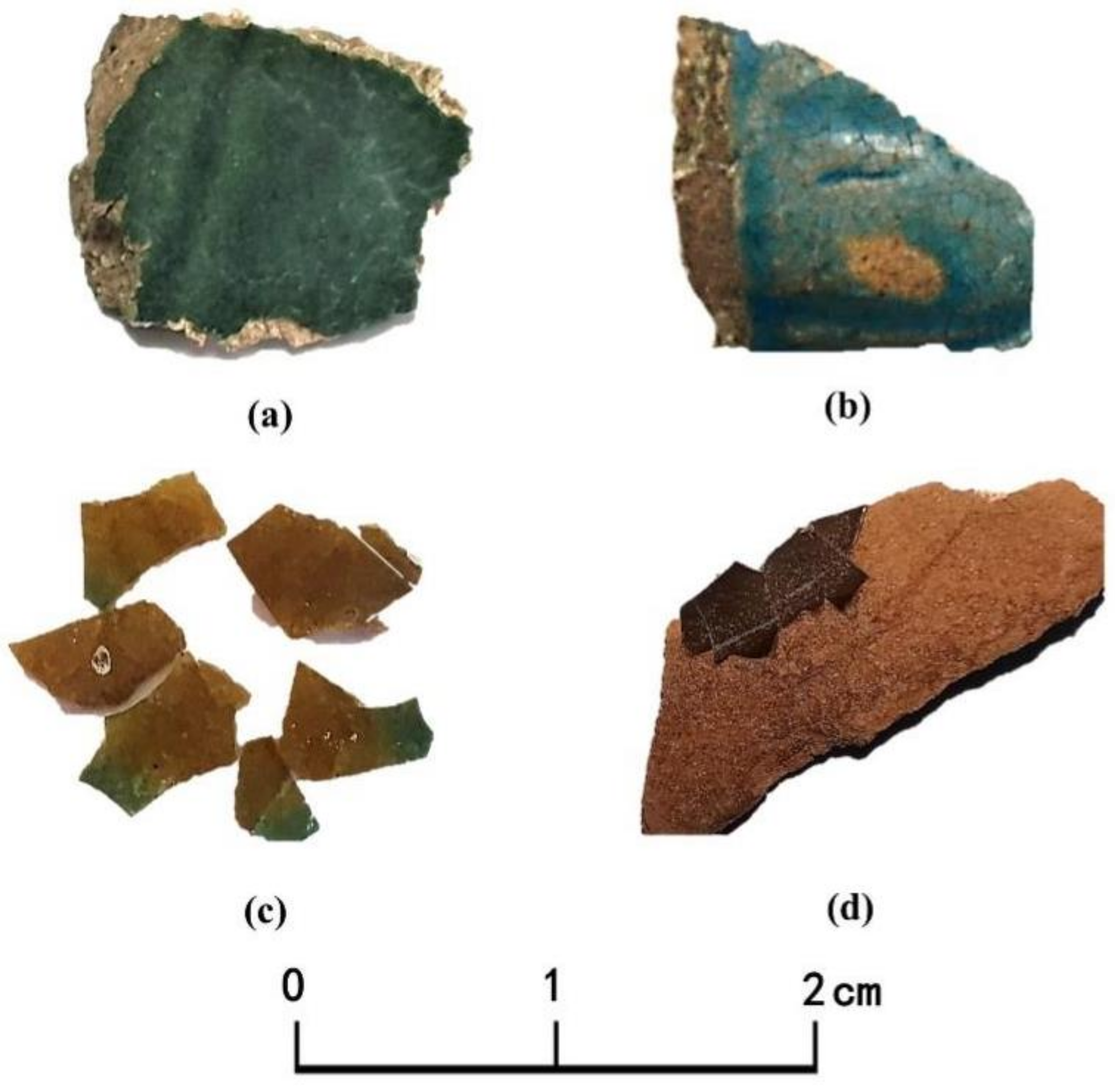

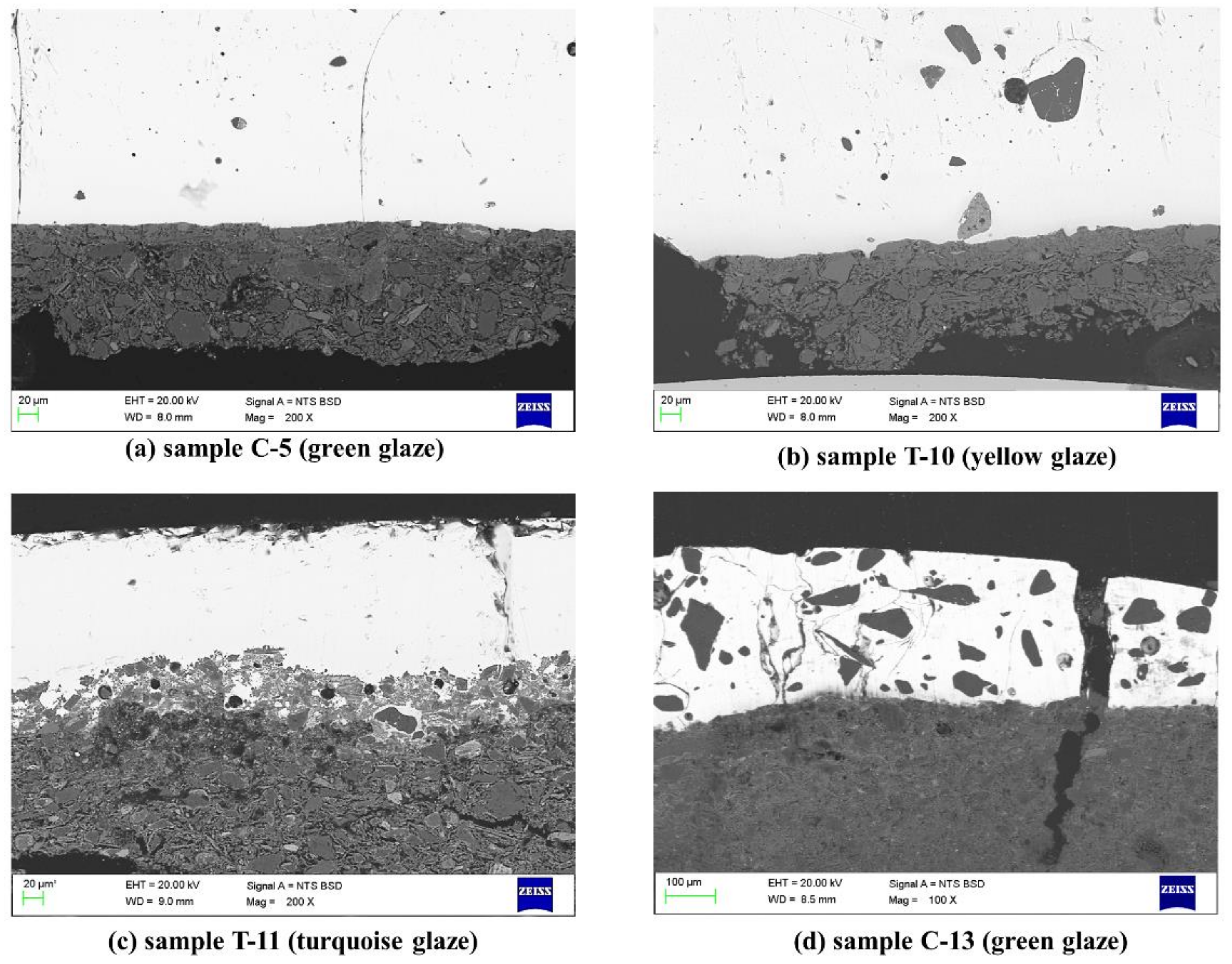
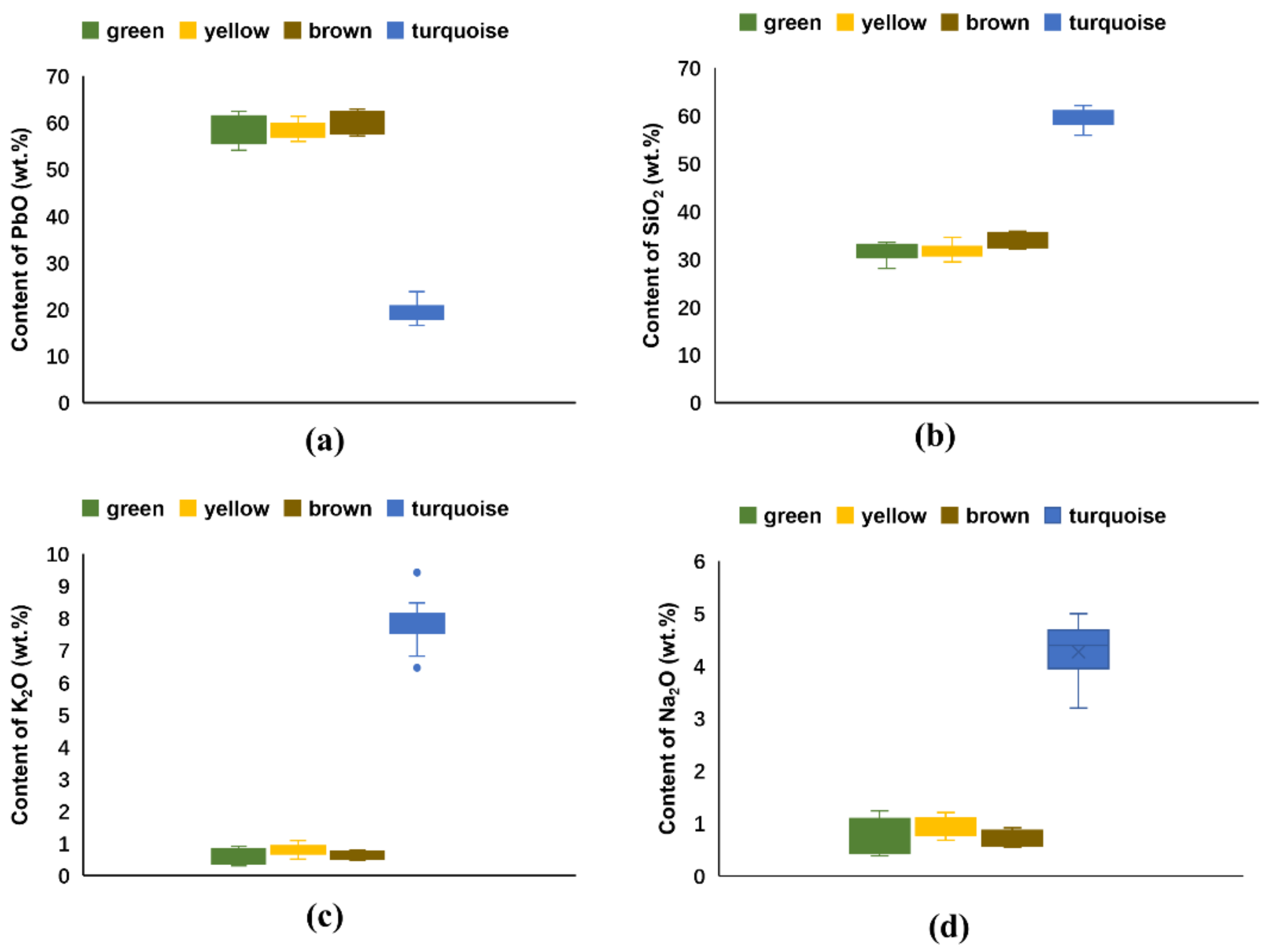
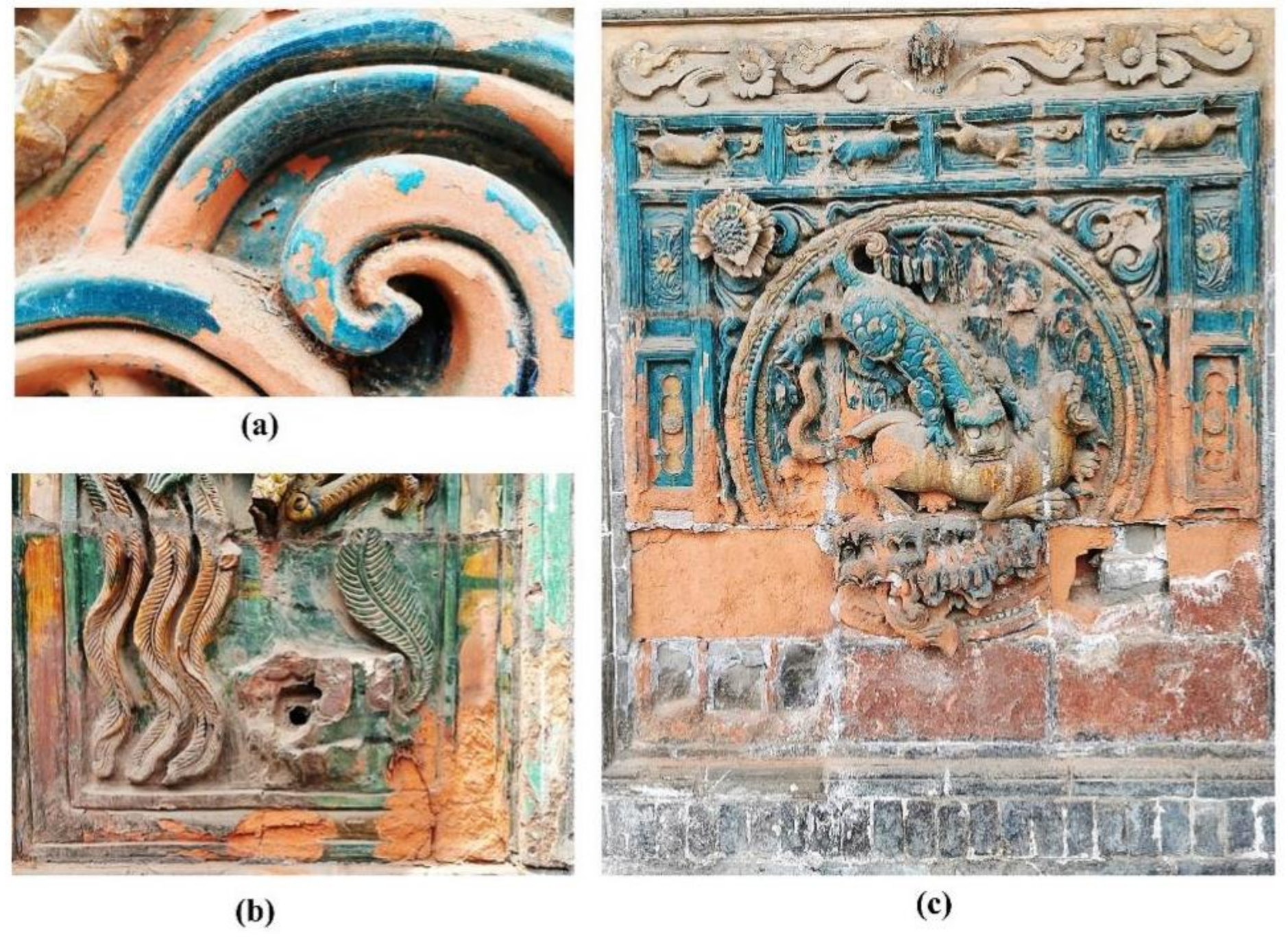
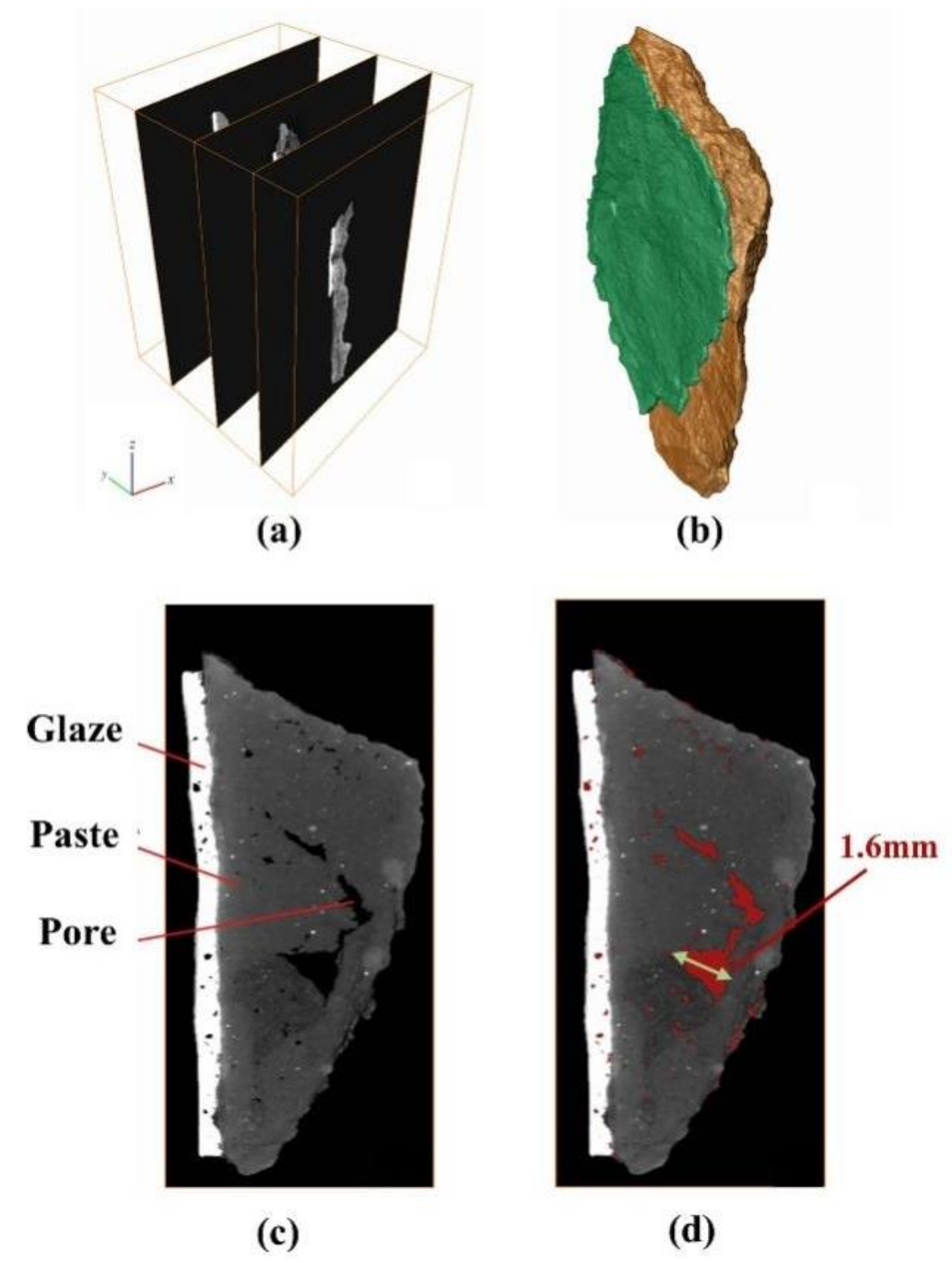
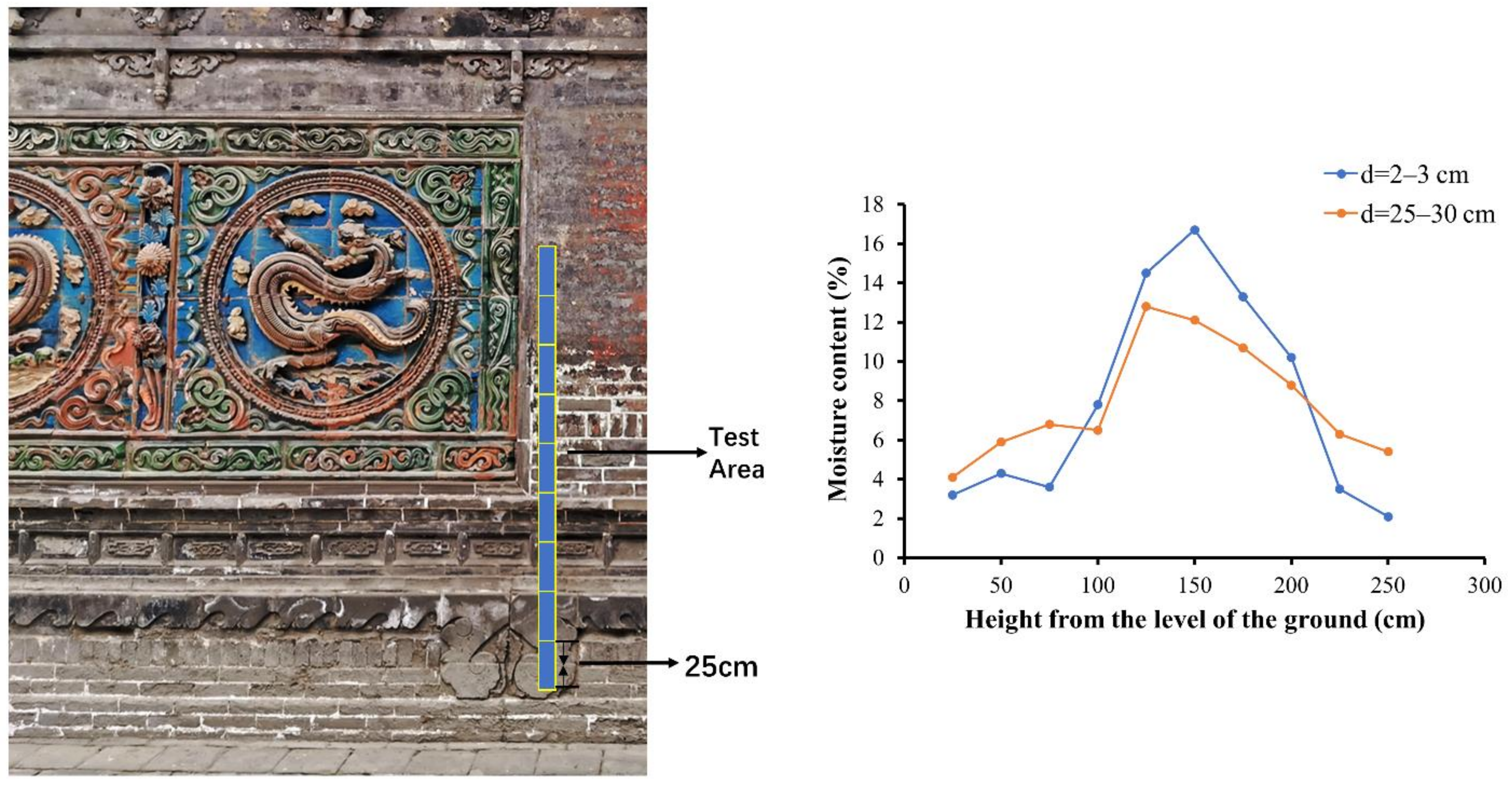
| Sample No. | Location | Production Year | Glaze Color | Sample No. | Location | Production Year | Glaze Color |
|---|---|---|---|---|---|---|---|
| Glazed tile samples from the Hancheng Confucian Temple | Glazed tile samples from the Hancheng Town God’ s Temple | ||||||
| C-1 | Five-Dragon screen wall | within the Wanli Period of the Ming Dynasty (1573–1620 AD) | green | T-1 | South screen wall | the 44th year of the Wanli Period of the Ming Dynasty (1616 AD) | turquoise |
| C-2 | green and yellow | T-2 | turquoise | ||||
| C-3 | turquoise | T-3 | yellow | ||||
| C-4 | brown | T-4 | yellow | ||||
| C-5 | East screen wall of Lingxing Gate | the 18th year of the Chenghua Period of the Ming Dynasty (1482 AD) | green | T-5 | West screen wall of Biping Gate | the 44th year of the Wanli Period of the Ming Dynasty (1616 AD) | turquoise |
| C-6 | green and yellow | T-6 | turquoise | ||||
| C-7 | yellow | T-7 | yellow | ||||
| C-8 | East screen wall of Halberd Gate | the 18th year of the Chenghua Period of the Ming Dynasty (1482 AD) | green | T-8 | turquoise | ||
| C-9 | turquoise | T-9 | East screen wall of Biping Gate | the 44th year of the Wanli Period of the Ming Dynasty (1616 AD) | yellow | ||
| C-10 | turquoise | T-10 | yellow | ||||
| C-11 | brown | T-11 | turquoise | ||||
| C-12 | West screen wall of Halberd Gate | the 18th year of the Chenghua Period of the Ming Dynasty (1482 AD) | yellow | T-12 | Screen walls of Xizhi Gate | within the Kangxi Period of the Qing Dynasty (1662–1722 AD) | yellow |
| C-13 | green and yellow | T-13 | green and brown | ||||
| C-14 | green and yellow | T-14 | green | ||||
| C-15 | yellow and turquoise | T-15 | green | ||||
| C-16 | brown | T-16 | East screen wall of Biping Gate | the 44th year of the Wanli Period of the Ming Dynasty (1616 AD) | turquoise | ||
| C-17 | turquoise | ||||||
| Sample No. | SiO2 | Al2O3 | Na2O | K2O | MgO | CaO | FeO |
|---|---|---|---|---|---|---|---|
| Glazed tile samples from the Hancheng Confucian Temple | |||||||
| C-1 | 60.2 | 18.7 | 1.8 | 4.1 | 3.1 | 5.9 | 6.1 |
| C-2 | 61.7 | 18.1 | 1.9 | 3.3 | 3.4 | 5.2 | 6.3 |
| C-3 | 61.9 | 18.5 | 2.5 | 2.8 | 3.0 | 5.8 | 5.4 |
| C-4 | 62.5 | 17.2 | 2.7 | 3.1 | 3.0 | 8.1 | 3.5 |
| C-5 | 62.4 | 16.5 | 2.1 | 2.9 | 2.6 | 8.3 | 5.2 |
| C-6 | 64.5 | 16.4 | 3.2 | 2.4 | 2.5 | 6.8 | 4.2 |
| C-7 | 61.3 | 15.0 | 2.9 | 4.1 | 2.8 | 8.1 | 6.0 |
| C-8 | 64.2 | 17.4 | 1.4 | 2.4 | 2.5 | 8.8 | 3.3 |
| C-9 | 62.5 | 17.0 | 2.3 | 2.4 | 3.0 | 8.7 | 4.0 |
| C-10 | 60.9 | 15.9 | 2.1 | 2.2 | 2.9 | 10.5 | 5.3 |
| Glazed tile samples from the Hancheng Town God’ s Temple | |||||||
| T-1 | 61.8 | 16.6 | 1.4 | 2.8 | 2.2 | 9.3 | 5.9 |
| T-2 | 60.9 | 17.3 | 2.6 | 2.7 | 3.6 | 7.5 | 5.5 |
| T-3 | 61.8 | 16.9 | 2.4 | 2.2 | 3.5 | 10.2 | 3.2 |
| T-4 | 63.4 | 17.7 | 1.9 | 1.9 | 2.6 | 9.8 | 2.9 |
| T-5 | 63.5 | 17.8 | 1.7 | 2.5 | 2.9 | 7.1 | 4.6 |
| T-6 | 61.8 | 16.7 | 2.9 | 3.1 | 2.9 | 8.3 | 4.0 |
| T-7 | 62.6 | 14.6 | 3.2 | 3.5 | 2.7 | 9.6 | 3.7 |
| T-8 | 62.9 | 15.8 | 2.8 | 3.4 | 2.3 | 7.4 | 5.3 |
| T-9 | 61.7 | 16.0 | 2.7 | 2.7 | 4.0 | 6.8 | 6.0 |
| T-10 | 65.7 | 17.7 | 2.5 | 2.3 | 2.5 | 5.4 | 4.0 |
| T-11 | 64.5 | 16.1 | 2.6 | 1.8 | 3.0 | 7.7 | 4.3 |
| T-12 | 65.7 | 16.5 | 2.3 | 2.1 | 2.4 | 7.3 | 3.7 |
| T-13 | 62.1 | 16.9 | 1.7 | 4.0 | 3.0 | 8.0 | 4.4 |
| Loess of North China (chemical compositions on average) [11] | |||||||
| Sandy loess (N = 23) | 69.3 | 12.9 | 2.2 | 2.5 | 2.6 | 7.8 | 2.8 |
| Loess (N = 97) | 66.3 | 13.7 | 1.9 | 2.6 | 2.7 | 9.3 | 3.3 |
| Clay loess (N = 27) | 65.6 | 13.9 | 1.8 | 2.6 | 2.7 | 10.1 | 3.4 |
| Analysis of loess-based North Chinese ceramics [12] | |||||||
| Qin terracotta warrior, Lishan | 66.3 | 16.6 | 2.0 | 3.3 | 2.3 | 2.0 | 6.1 |
| Qin terracotta horse, Lishan | 63.2 | 15.9 | 1.6 | 2.9 | 2.1 | 2.6 | 6.1 |
| Han dynasty funerary jar | 65.8 | 15.8 | 1.6 | 3.3 | 2.1 | 2.1 | 5.2 |
| Shang dynasty earthenware pipe | 66.5 | 16.9 | 1.3 | 3.0 | 2.0 | 2.8 | 6.5 |
| Yuan dynasty glazed tiles (N = 8), the Palace Museum [13] | 62.1 | 16.8 | 2.2 | 2.6 | 2.6 | 8.2 | 4.6 |
| Sample No. | Location | Mineral Composition |
|---|---|---|
| C-1 | Five-Dragon screen wall (1573–1620AD) | quartz, K-feldspar, plagioclase, mullite, calcite, dolomite, hematite |
| C-2 | quartz, K-feldspar, plagioclase, gypsum, mullite, hematite | |
| C-3 | quartz, K-feldspar, plagioclase, mullite, dolomite, hematite | |
| C-5 | East screen wall of Lingxing Gate (1482AD) | quartz, K-feldspar, plagioclase, calcite, illite, hematite |
| C-6 | quartz, K-feldspar, plagioclase, dolomite, mullite, hematite | |
| C-8 | East screen wall of Halberd Gate (1482AD) | quartz, K-feldspar, plagioclase, mullite, calcite, dolomite, hematite |
| C-9 | quartz, K-feldspar, plagioclase, mullite, gypsum, calcite, dolomite, hematite | |
| C-10 | quartz, K-feldspar, plagioclase, gypsum, mullite, hematite | |
| T-1 | South screen wall (1616AD) | quartz, K-feldspar, plagioclase, calcite, illite, hematite |
| T-2 | quartz, K-feldspar, plagioclase, calcite, illite, dolomite, hematite | |
| T-3 | quartz, K-feldspar, plagioclase, gypsum, illite, hematite | |
| T-4 | quartz, K-feldspar, plagioclase, calcite, illite, hematite | |
| T-5 | West screen wall of Biping Gate (1616AD) | quartz, K-feldspar, plagioclase, mullite, dolomite, hematite |
| T-8 | quartz, K-feldspar, plagioclase, dolomite, mullite, hematite | |
| T-9 | East screen wall of Biping Gate (1616AD) | quartz, K-feldspar, plagioclase, dolomite, mullite, hematite |
| T-10 | quartz, K-feldspar, plagioclase, mullite, hematite | |
| T-12 | Screen walls of Xizhi Gate (1662–1722AD) | quartz, K-feldspar, plagioclase, mullite, calcite, hematite |
| T-13 | quartz, K-feldspar, plagioclase, mullite, calcite, hematite |
| Sample No. | Glaze Colour | PbO | SiO2 | Al2O3 | FeO | CuO | Na2O | K2O | CaO | MgO | TiO2 |
|---|---|---|---|---|---|---|---|---|---|---|---|
| C-1G | Green | 62.7 | 28.3 | 1.9 | 0.8 | 2.6 | 1.1 | 0.6 | 1.2 | 0.8 | b.d. |
| C-2G | 59.0 | 31.6 | 1.8 | 0.5 | 3.7 | 1.0 | 0.3 | 1.3 | 0.3 | 0.2 | |
| C-5G | 61.3 | 30.1 | 2.3 | 0.5 | 2.9 | 0.4 | 0.3 | 0.9 | 0.9 | 0.1 | |
| C-6G | 62.8 | 30.6 | 1.8 | 0.6 | 2.3 | 0.4 | 0.4 | 0.8 | 0.2 | 0.1 | |
| C-8G | 56.4 | 33.2 | 2.7 | 0.7 | 4.3 | 0.5 | 0.9 | 0.5 | 0.8 | b.d. | |
| C-13G | 58.3 | 32.3 | 2.0 | 0.5 | 4.6 | 0.4 | 0.9 | 0.5 | 0.5 | 0.2 | |
| C-14G | 57.6 | 31.7 | 2.1 | 0.7 | 3.7 | 0.7 | 0.7 | 1.3 | 0.9 | 0.2 | |
| T-13G | 54.5 | 33.8 | 1.3 | 0.9 | 5.5 | 1.1 | 0.8 | 1.3 | 0.6 | 0.1 | |
| T-14G | 55.2 | 33.7 | 2.0 | 0.9 | 4.5 | 1.3 | 0.8 | 0.9 | 0.6 | 0.2 | |
| T-15G | 60.1 | 30.6 | 2.2 | 0.6 | 3.1 | 0.9 | 0.8 | 1.0 | 0.4 | b.d. | |
| C-2Y | Yellow | 58.5 | 32.1 | 2.2 | 3.1 | 0.2 | 1.1 | 0.7 | 1.1 | 0.5 | 0.2 |
| C-6Y | 57.0 | 33.2 | 2.5 | 3.0 | b.d. | 1.1 | 0.8 | 1.6 | 0.9 | b.d. | |
| C-7Y | 55.9 | 33.6 | 2.7 | 2.7 | b.d. | 1.2 | 0.9 | 1.6 | 0.7 | 0.2 | |
| C-12Y | 59.4 | 32.2 | 1.7 | 3.3 | b.d. | 1.0 | 0.9 | 0.9 | 0.4 | 0.2 | |
| C-13Y | 60.6 | 30.7 | 1.5 | 4.0 | 0.1 | 1.0 | 0.8 | 0.8 | 0.5 | b.d. | |
| C-14Y | 57.3 | 34.9 | 0.9 | 3.7 | b.d. | 0.9 | 1.1 | 0.8 | 0.4 | b.d. | |
| C-15Y | 61.8 | 31.1 | 0.9 | 3.3 | b.d. | 0.8 | 0.9 | 0.7 | 0.6 | b.d. | |
| T-3Y | 58.5 | 31.8 | 1.7 | 4.6 | b.d. | 0.7 | 0.8 | 0.8 | 0.7 | 0.1 | |
| T-4Y | 59.9 | 31.2 | 2.0 | 4.5 | 0.1 | 0.7 | 0.5 | 0.9 | 0.2 | b.d. | |
| T-7Y | 59.7 | 30.6 | 2.0 | 4.6 | b.d. | 0.7 | 0.7 | 1.1 | 0.4 | 0.2 | |
| T-9Y | 57.2 | 32.6 | 1.8 | 5.0 | b.d. | 0.9 | 0.7 | 1.3 | 0.5 | 0.2 | |
| T-10Y | 60.3 | 29.6 | 1.8 | 4.0 | b.d. | 0.9 | 1.0 | 1.8 | 0.6 | b.d. | |
| T-12Y | 59.4 | 32.1 | 2.4 | 2.6 | 0.1 | 1.2 | 0.7 | 0.6 | 0.7 | b.d. | |
| C-4B | Brown | 58.9 | 32.2 | 2.2 | 4.2 | b.d. | 0.9 | 0.8 | 0.6 | 0.3 | b.d. |
| C-11B | 60.8 | 31.2 | 1.5 | 4.3 | b.d. | 0.6 | 0.6 | 0.6 | 0.5 | b.d. | |
| C-16B | 58.3 | 35.5 | 1.6 | 2.4 | b.d. | 0.7 | 0.7 | 0.5 | 0.3 | b.d. | |
| T-13B | 58.8 | 35.4 | 1.6 | 2.2 | b.d. | 0.6 | 0.5 | 0.7 | 0.2 | b.d. | |
| C-3T | Turquoise | 18.6 | 62.6 | 1.5 | 0.6 | 2.0 | 4.7 | 7.7 | 0.9 | 0.9 | b.d. |
| C-9T | 16.7 | 62.1 | 2.0 | 0.3 | 2.3 | 4.5 | 9.5 | 1.4 | 0.9 | b.d. | |
| C-10T | 17.7 | 62.3 | 1.1 | 0.7 | 3.4 | 4.8 | 8.5 | 0.8 | 0.4 | b.d. | |
| C-15T | 18.8 | 60.3 | 2.6 | 0.7 | 2.6 | 4.1 | 8.2 | 0.9 | 1.4 | 0.3 | |
| C-17T | 21.2 | 59.3 | 1.2 | 0.4 | 3.8 | 4.2 | 7.7 | 0.9 | 0.7 | 0.2 | |
| T-1T | 22.0 | 56.3 | 1.5 | 0.9 | 4.7 | 3.2 | 7.7 | 1.5 | 1.8 | 0.1 | |
| T-2T | 24.0 | 56.7 | 1.8 | 0.6 | 4.4 | 3.9 | 6.9 | 0.9 | 0.6 | 0.2 | |
| T-5T | 19.9 | 59.0 | 2.1 | 0.9 | 4.1 | 3.6 | 8.2 | 0.9 | 1.0 | b.d. | |
| T-6T | 18.4 | 60.6 | 2.0 | 0.3 | 4.3 | 4.1 | 7.9 | 1.1 | 1.1 | b.d. | |
| T-8T | 17.4 | 60.1 | 1.6 | 1.0 | 4.9 | 4.9 | 7.9 | 0.8 | 1.0 | 0.1 | |
| T-11T | 19.8 | 60.2 | 1.3 | 0.7 | 3.4 | 4.6 | 7.8 | 1.0 | 0.5 | 0.2 | |
| T-16T | 19.4 | 60.4 | 2.3 | 0.8 | 3.2 | 5.0 | 6.5 | 0.9 | 1.1 | 0.2 |
| Information of Historical Record | Glaze Recipe of Glazed Tile | |||||
|---|---|---|---|---|---|---|
| Name | Description | PbO | SiO2 | FeO | CuO | PbO:SiO2 |
| Yingzao Fashi | Published in 1103 AD of the Song Dynasty The oldest technical treatise on architecture and craftmanship found in China | Lithargite 1500 g 69.9 wt.% | Luohe stone (a kind of quartzite) 500 g 23.3 wt.% | / | Copper powder 150 g 7.0 wt.% | 3:1 |
| Gongbuchangku Xuzhi | Published in 1615 AD of the Ming Dynasty It records the rules and management system of construction engineering in the Ming Dynasty | Lithargite 153 kg 73.6 wt.% | Maya stone (a kind of quartzite) 51 kg 24.5 wt.% | Ocher(a kind of hematite) 4 kg 1.9 wt.% | / | 3:1 |
Publisher’s Note: MDPI stays neutral with regard to jurisdictional claims in published maps and institutional affiliations. |
© 2021 by the authors. Licensee MDPI, Basel, Switzerland. This article is an open access article distributed under the terms and conditions of the Creative Commons Attribution (CC BY) license (https://creativecommons.org/licenses/by/4.0/).
Share and Cite
Shen, J.; Li, L.; Wang, J.-P.; Li, X.; Zhang, D.; Ji, J.; Luan, J.-Y. Architectural Glazed Tiles Used in Ancient Chinese Screen Walls (15th–18th Century AD): Ceramic Technology, Decay Process and Conservation. Materials 2021, 14, 7146. https://doi.org/10.3390/ma14237146
Shen J, Li L, Wang J-P, Li X, Zhang D, Ji J, Luan J-Y. Architectural Glazed Tiles Used in Ancient Chinese Screen Walls (15th–18th Century AD): Ceramic Technology, Decay Process and Conservation. Materials. 2021; 14(23):7146. https://doi.org/10.3390/ma14237146
Chicago/Turabian StyleShen, Jingyi, Li Li, Ji-Peng Wang, Xiaoxi Li, Dandan Zhang, Juan Ji, and Ji-Yuan Luan. 2021. "Architectural Glazed Tiles Used in Ancient Chinese Screen Walls (15th–18th Century AD): Ceramic Technology, Decay Process and Conservation" Materials 14, no. 23: 7146. https://doi.org/10.3390/ma14237146
APA StyleShen, J., Li, L., Wang, J.-P., Li, X., Zhang, D., Ji, J., & Luan, J.-Y. (2021). Architectural Glazed Tiles Used in Ancient Chinese Screen Walls (15th–18th Century AD): Ceramic Technology, Decay Process and Conservation. Materials, 14(23), 7146. https://doi.org/10.3390/ma14237146






